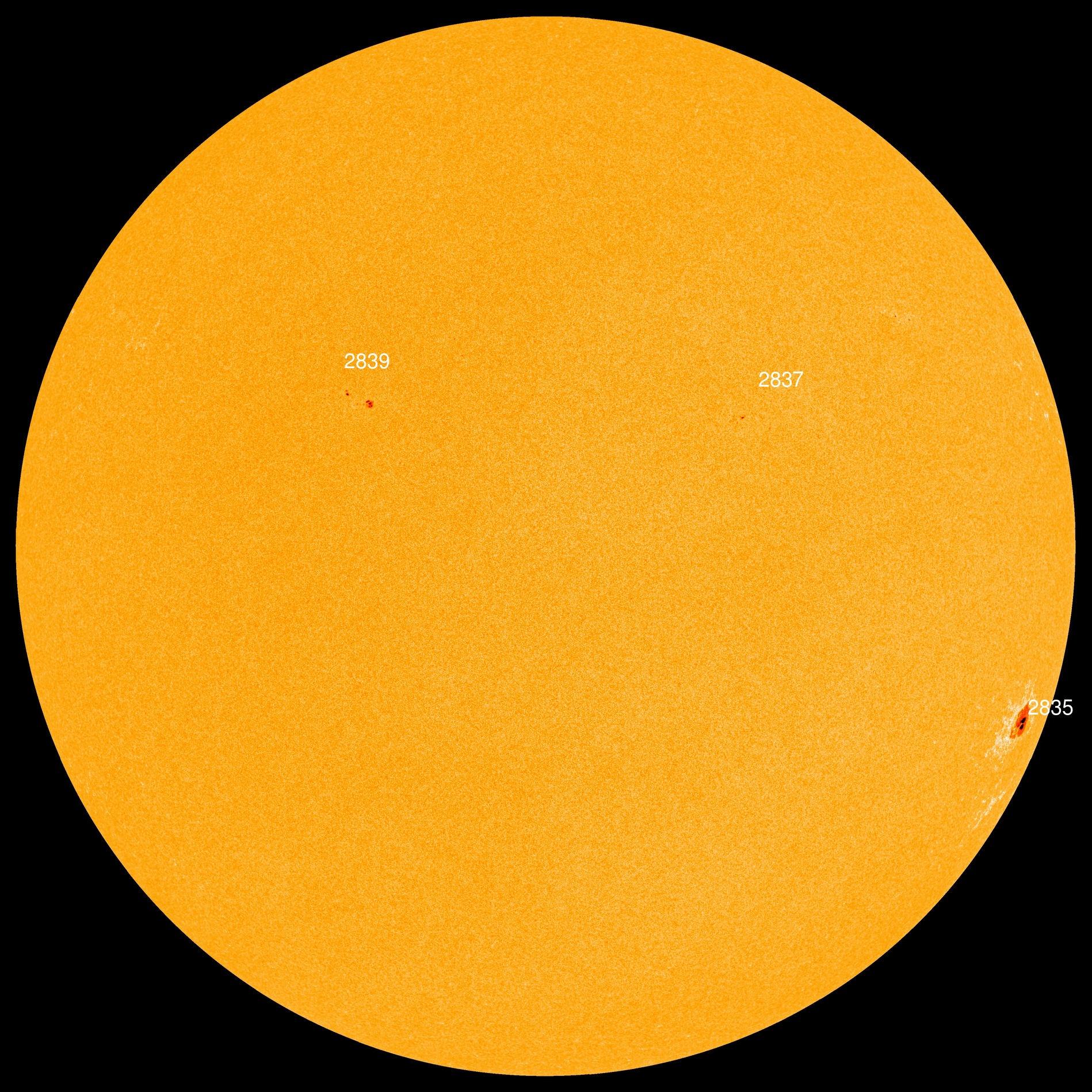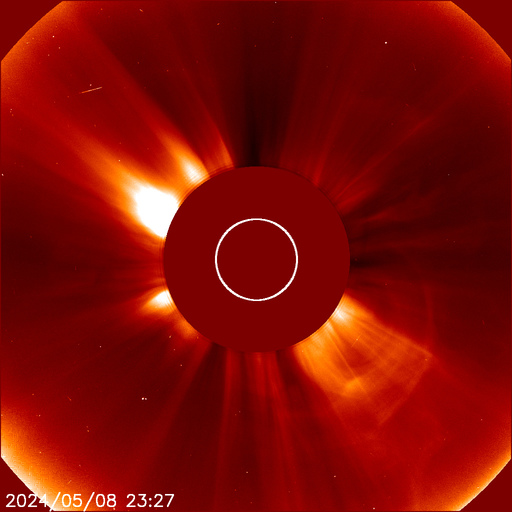The Hubble Remains Offline.
The Hubble Space Telescope remains in safe mode as NASA engineers “review and update all of the operations procedures, commands and other related items necessary to perform the switch to backup hardware. They will then test their execution against a high-fidelity simulator.”
A similar hardware swap was performed in 2008, allowing the Hubble to continue science operations after a CU/SDF module failure. I hope the engineers are able to pull-off this bit of technological wizardry.

Jupiter and Saturn appear low in the southeastern sky at midnight. They are at their highest in the southern sky around 4:00 AM, and fade into the dawn high in the south-southwestern sky around 5:30 AM.

Mercury returns to the in the eastern predawn sky at the end of June; it appears highest above the horizon on July 8th, and will vanish into the glare of the Sun around July 20th.
Mars and Venus appear in the western sky at dusk.

Mars and Venus appear a little over 3° apart on July 6th, and only 0° 31′ apart on July 12th. The waxing crescent Moon appears near the pair of planets on July 11th and 12th.
Here’s a close-up of the Venus-Mars conjunction on July 12th:


- The Moon is a Waning Crescent – visible low to the east before sunrise.
- The New Moon occurs on July 9th – the Moon will not be visible.
- After July 9th, the Moon will be a Waxing Crescent – visible toward the southwest in early evening.

If you click on the Moon image above, or click this link, you will go to NASA’s Moon Phase and Libration, 2021 page – it will show you what the Moon looks like right now. If you click the image on that page, you will download a high-rez TIFF image annotated with the names of prominent features – helpful for logging your lunar observations!
Moon News:

The Sun has another 3 sunspots (Hah ha ha!) SpaceWeather.com says “Sunspot AR2835 is cracking up. It is now split down the middle, signaling a breakup.”

SpaceWeather.com also says: “On July 3rd, sunspot AR2838 unleashed the first X-flare of Solar Cycle 25. Hours later, the sunspot disappeared–but it hasn’t stopped flaring. Two CMEs just flew away from the farside of the sun where AR2838 is now located. If it holds together long enough, the sunspot will return to the Earthside in less than 2 weeks.”
You can view the Sun in near real-time, in multiple frequencies here: SDO-The Sun Now.
You can create your own time-lapse movies of the Sun here: AIA/HMI Browse Data.
You can browse all the SDO images of the Sun from 2010 to the present here: Browse SDO archive.
Solar Activity on Facebook – Run by Volunteer NASA/JPL Solar System Ambassador Pamela Shivak

Solar Corona
Solar wind speed is 359.8 km/sec ▲, with a density of 11.4 protons/cm3 ▲ at 1251 UT.
Click here to see a near real-time animation of the corona and solar wind from the Solar & Heliospheric Observatory (SOHO).
Sun News: WOW! The Sun Blew-off a BIG One!

- Near-Earth Objects (NEOs) discovered this month: 8, this year: 1308 (+21), all time: 26,144 (+21)
- Potentially hazardous asteroids: 2189 (+1) (updated 2021-07-06)
- Total Minor Planets discovered (NASA): 1,100,410 (+3,262)
- Total Minor Planets discovered (MPC): 1,086,655 (updated 2021-06-22)
A newly named asteroid from WGSBN Bulletin 1, #4 (July 4):

(332632) Pharos = 2008 UO1
Discovery: 2008-10-22 / V. S. Casulli / Vallemare Borbona / A55
The Pharos of Alexandria was considered one of the seven wonders of the ancient world. This lighthouse, one of the tallest structures in the world at the time, was built on the island of Pharos, in front of the port of Alexandria of Egypt, and was destroyed by two earthquakes.
Upcoming Earth-asteroid encounters:
| Asteroid | Date(UT) | Miss Distance | Velocity (km/s) | Diameter (m) |
| 2021 MC | 2021-Jul-06 | 3 LD | 7.1 | 23 |
| 2021 NF | 2021-Jul-06 | 8.4 LD | 10.4 | 38 |
| 2021 NG | 2021-Jul-08 | 6 LD | 8.7 | 22 |
| 2021 NE | 2021-Jul-10 | 5.8 LD | 9.7 | 17 |
| 2019 AT6 | 2021-Jul-13 | 4.2 LD | 5.1 | 11 |
| 2019 NB7 | 2021-Jul-17 | 15.2 LD | 13.8 | 12 |
| 2014 BP43 | 2021-Jul-21 | 17 LD | 8.5 | 18 |
| 2008 GO20 | 2021-Jul-24 | 12.8 LD | 8.2 | 123 |
| 2020 BW12 | 2021-Jul-27 | 16.7 LD | 9.8 | 21 |
| 2019 YM6 | 2021-Jul-31 | 17.9 LD | 13.5 | 135 |
| 2020 PN1 | 2021-Aug-03 | 9.6 LD | 4.6 | 30 |
| 2020 PP1 | 2021-Aug-03 | 13 LD | 3.6 | 16 |
| 2012 BA35 | 2021-Aug-11 | 6.9 LD | 4.2 | 62 |
| 2016 BQ | 2021-Aug-14 | 4.4 LD | 4.7 | 16 |
| 2016 AJ193 | 2021-Aug-21 | 8.9 LD | 26.2 | 709 |
| 2019 UD4 | 2021-Aug-22 | 14.2 LD | 5.5 | 85 |
| 2020 BC16 | 2021-Aug-24 | 15 LD | 6.7 | 34 |
| 2011 UC292 | 2021-Aug-24 | 9 LD | 8.5 | 98 |
| 2017 RK15 | 2021-Aug-29 | 13.3 LD | 11.6 | 26 |
Asteroid News:

On July 5, 2021, the NASA All Sky Fireball Network reported 5 fireballs!
(5 sporadics)

Fireball News:
If you see a bright meteor or a fireball, please REPORT IT to the American Meteor Society and the International Meteor Organization!

Position of the planets & several spacecraft in the inner solar system on July 6th:

Position of the planets in the middle solar system – the orbit of dwarf planet Ceres is highlighted:

Position of the planets in the outer solar system – the trajectory of interstellar comet A/2017 U1 (Oumuamua) is shown in white.

Solar System News:

See a list of current NASA missions here: https://www.jpl.nasa.gov/missions?mission_status=current

ex·o·plan·et /ˈeksōˌplanət/, noun: a planet orbiting a star other than the Sun.
Data from the NASA Exoplanet Archive
* Confirmed Planets Discovered by TESS refers to the number planets that have been published in the refereed astronomical literature.
* TESS Project Candidates refers to the total number of transit-like events that appear to be astrophysical in origin, including false positives as identified by the TESS Project.
* TESS Project Candidates Yet To Be Confirmed refers to the number of TESS Project Candidates that have not yet been dispositioned as a Confirmed Planet or False Positive.
Exoplanet News:


SpaceWeather.com Realtime Aurora Gallery: https://spaceweathergallery.com/aurora_gallery.html

Appalachian Mtn Club Maine Woods property becomes first Dark Sky Park in New England.
- Visit an International Dark Sky Park: https://www.darksky.org/our-work/conservation/idsp/parks/
- If you live in Michigan, visit the Michigan Dark Skies site: https://sites.lsa.umich.edu/darkskies/

Seeing the Milky Way from Andromeda
I saw this post from Astronomy Magazine this morning, and I HAD to see what the Milky Way looked like from the Andromeda galaxy.
I fired up SpaceEngine, flew from Earth to the Andromeda galaxy, searched for an interesting planet, and took this screenshot. The planet orbits a star in the halo of the Andromeda galaxy; satellite galaxy M 110 can be seen between the planet and its rings, the Milky Way is to the upper right.

From the same exoplanet location, I centered on the Milky Way galaxy and zoomed-in to create this view of the Milky Way and the LMC:

Stay safe, be well, and look up!
Software Apps used for this post:
NASA Eyes on the Solar System: an immersive 3D solar system and space mission simulator – free for the PC /MAC. I maintain the unofficial NASA Eyes Facebook page.
SpaceEngine: a free 3D Universe Simulator for Windows. Steam version with VR support available.
Stellarium: a free open source planetarium app for PC/MAC/Linux. It’s a great tool for planning observing sessions. A web-based version of Stellarium is also available.






